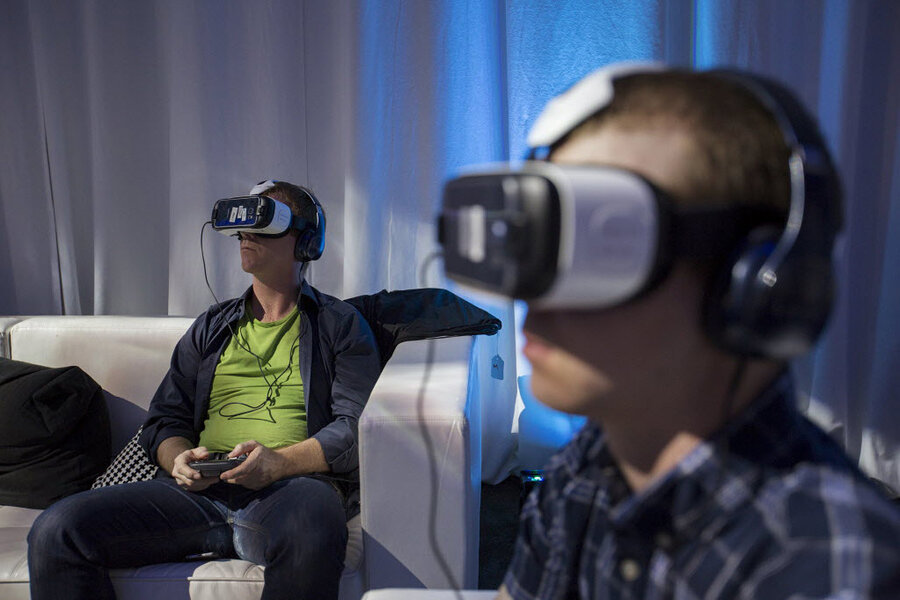Why Samsung's Gear VR headset is so impressive, especially for videos
Loading...
| New York
Samsung makes history of a sort Friday by launching the first major consumer-oriented virtual-reality headset. (It comes with an asterisk; prototypes and other not-quite-mass-market versions have been available for a while.) And its Gear VR headset is pretty impressive as first-generation devices go.
The biggest surprise after using the new Gear VR for a few days: There's a lot of stuff to watch and play in the virtual worlds the headset opens up. Granted, some of that material is gimmicky or amateurish. But the best of it hints at some of the mind-expanding experiences VR can make possible.
The Gear VR is relatively cheap, too, at just $100. You do need your own headphones, preferably wireless, plus a recent Samsung phone — the Galaxy S6, S6 Edge, S6 Edge Plus or Note 5. If you don't already have one, the package could set you back nearly $1,000. (Other VR systems will also need companion devices, such as high-end personal computers.)
Samsung developed the Gear VR with the virtual-reality startup Oculus (now part of Facebook). It supplants the $200 "innovator edition" Samsung has sold for a year. That earlier prototype was mainly intended to build enthusiasm for VR and to help developers start producing games and apps for it. Samsung bills the new model as its first consumer VR product, although it still requires some savvy on the consumer's part to use.
___
ABOUT THE DEVICE
Your phone attaches to the front of the Gear VR headset, just in front of the lens for your eyes. Put the headset on, and your surroundings disappear as the phone screen opens a window into an unreal, three-dimensional world. As you turn your head, the image shifts accordingly to give the sense of being there in real life. You can even turn all the way around to see what's behind you. The screen projects slightly different perspectives to your left and right eyes to give the virtual world depth.
The Gear VR wasn't easy to set up. I had trouble figuring out where all the Velcro straps and hooks were supposed to go. I couldn't get the phone to snap into place. I needed the manual to find a lever I had to switch because I had a larger phone, the Note 5. Many consumers might need help from a tech-savvy friend or kid.
I also got frustrated having to wait for apps and video to download — a few minutes in some cases. The Gear VR can stream relatively few videos for instant playback.
___
WHAT TO DO WITH IT
Fortunately, it was worth the wait most of the time, even if many of the videos seemed like concepts intended to demonstrate the Future of Virtual Reality or are merely promotions for regular movies and TV shows. A lot of it is free, though some videos or apps will set you back $2 to $10.
And some apps were surprisingly absorbing. The notion of the Netflix app, which streams video to a virtual TV in front of you, initially seemed silly. Why not watch a real TV? Well, the virtual TV is huge, much larger than what I could afford in real life. And VR also removes the distractions surrounding you — such as Facebook.
Repeat viewings sometimes turned up unexpected detail. Not until a second viewing of a Cirque du Soleil video did I notice performers to my left and right. In a horror video, I initially kept my eyes on a woman in distress; only later did I see scary creatures crawling out of a playground. You're no longer stuck with whatever the director chooses for you.
But one video of the Oct. 13 Democratic presidential debate was disappointing. There were four VR cameras around the room, but you couldn't pick the one to watch. And in 3-D, candidates looked like dolls on stage. It was a novel idea, but it'll take time to figure out what works and what doesn't. This one was also long, while the best ones were typically a few minutes each.
A few apps also have interactive elements. One lets you walk around a cafe depicted in the Vincent Van Gogh painting "The Night Cafe." Another lets you explore an island and solve puzzles to open doors. It made me nauseous, though.
It'll be great to see interactive storytelling, with plot lines that change depending on which rooms you choose to explore. And eventually filmmakers will rely less on stationary cameras. A VR piece featuring a hike with Reese Witherspoon could have let you hike with her, rather than watch from afar.
___
COMPARISONS
The Gear VR is meant for use while sitting down, ideally in a swivel chair. You can't walk around and explore your virtual environment. (You might trip over the ottoman or break things if you tried.)
The upcoming HTC Vive does offer that kind of walkabout experience, though you'll also need an uncluttered room. That offers the possibility of brand-new VR experiences, such as walking around Mars or a building you just designed.
The Vive, along with the Sony PlayStation VR and the Oculus Rift, will do much more than Gear VR, but will likely cost many times the $100 the Gear VR will set you back. Samsung's gadget is impressive for the price.





